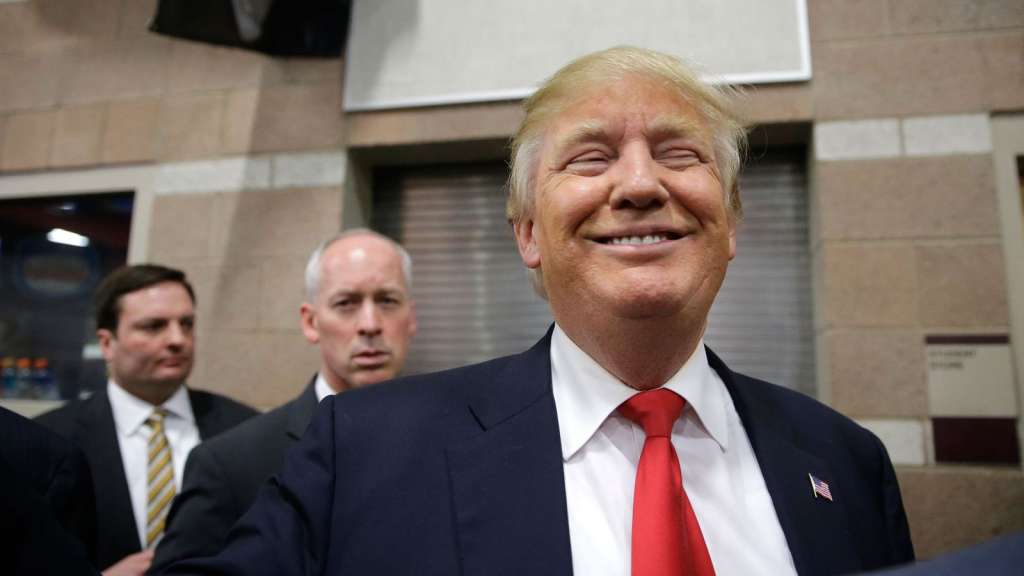NEW YORK (AP) — It’s a staple of nearly every Donald Trump rally: a boast from the candidate about his massive crowd size, a claim — sometimes true and sometimes not — that thousands more outside are hoping to get in, and a belief that the turnout foreshadows victory in November.
“I actually think I’m going good, I have the biggest crowds,” Trump told Fox on Tuesday, in light of sinking poll numbers. “Nobody’s ever had crowds like this.”
And on Wednesday, Trump hired Stephen Bannon, head of Breitbart News, to head his campaign with an eye on playing up his populist message — and to double down on his raucous rallies.
But Trump may be buying into the hype. Crowd size is frequently not a good indicator of success on Election Day — and some Republicans attribute Trump’s refusal to alter his message for the general election to his insistence on measuring success by the adulation he receives from audiences he’s already won over. In a general election, candidates typically broaden their message to reach the people not in the event halls, who have yet to be convinced.
“Campaigns that rely too much on anecdotal evidence like crowd sizes when looking to measure progress are easily lulled into a false sense of security,” said Kevin Madden, a senior adviser on Mitt Romney’s 2012 campaign. “They assume, often wrongly, that the echo effect of being surrounded by big crowds of already converted voters is automatically translating into momentum.”
Boisterous, often full-house rallies have long been the lynchpin of Trump’s campaign, and the Republican nominee took to Twitter in recent days to complain that the media were not giving them the credit they deserve.
“My rallies are not covered properly by the media. They never discuss the real message and never show crowd size or enthusiasm,” Trump posted Sunday.
Madden, who does not support Trump, recalls that in the closing days of the campaign four years ago, Romney drew massive crowds on each side of Pennsylvania, one outside Philadelphia and one in Pittsburgh on Election Day.
“Based on crowd size, you’d have thought we had a good chance to win the state, but we ended up losing by about five points,” Madden said. “The crowd sizes were there, but the data and the empirical evidence never really were.”
Crowd size can play a useful role in developing campaign strategy. A candidate’s team always searches for evidence to inform such decisions as to where and when to spend advertising money, which states the candidate should visit and how best to get voters to the polls on Election Day. Campaigns often must balance empirical evidence, like polls and organizational metrics, against anecdotal clues, like crowd size and enthusiasm.
Many Republicans underestimated Trump’s success in drawing crowds early in the primaries and the depth of his support among the GOP base.
But Trump has continued to make the rallies the centerpiece of his campaign and his routine in front of his raucous crowds hasn’t evolved much. He still delivers red-meat promises to build a wall along the Mexican border, belittles the media and brags about his primary victories, with little attempt to widen his message to target the far more expansive general election.
“I think he plays to the crowd and that’s not necessarily a good thing in a campaign where you need tens of millions of votes,” said GOP strategist Mike DuHaime, who advised Trump ally Chris Christie’s presidential bid. “Playing just to the crowd doesn’t work.”
But rallies can also provide a useful tactical tool. In 2008, Barack Obama also wowed political pundits with the size of his crowds, collecting voter data from attendees. Bernie Sanders routinely drew bigger crowds than Hillary Clinton, dwarfing her small-donor fundraising totals.
Crowd size also can translate into a wave of small campaign donors. Trump has proven very successful in receiving small donations, which he said made up the bulk of the $82 million he and the party brought in last month.
But despite his usual bravado about his rallies, Trump once let slip publicly that he had some doubts about the relevance of the large, enthusiastic crowds he still draws night after night.
“You’ve got thousands of people outside trying to get in (today), and this is one hell of a big stadium,” the Republican nominee said earlier this month in Jacksonville, Florida.
“I hear we’re leading Florida by a bit,” he said. “I don’t know why we’re not leading by a lot. Maybe crowds don’t make the difference.”
What political news is the world searching for on Google and talking about on Twitter? Find out via AP’s Election Buzz interactive. http://elections.ap.org/buzz
Jill Colvin in West Bend, Wisconsin, and Thomas Beaumont in Des Moines, Iowa, contributed to this report.
Follow Jonathan Lemire on Twitter at: http://twitter.com/JonLemire
Copyright 2024 The Associated Press. All rights reserved. This material may not be published, broadcast, rewritten or redistributed.

